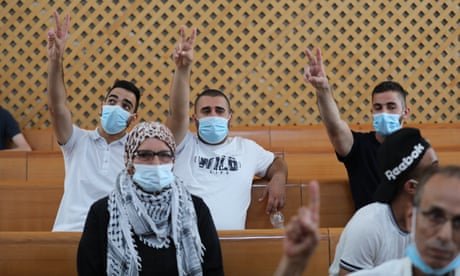Man has reportedly threatened to set himself on fire if removal order in Jerusalem district is carried out

Agence France-Presse in Jerusalem
Mon 17 Jan 2022
Israeli police are in a standoff with a Palestinian man who carried a gas canister on to the roof of his home in a Jerusalem flashpoint district as his family faced eviction.
Israeli media reported that Mohammed Salhiya had threatened to set himself on fire if the eviction order from the Sheikh Jarrah area of Israeli-annexed East Jerusalem was carried out.
Salhiya’s family has been facing an eviction threat since 2017, when the land where his home sits was allocated for school construction.
Police and the Jerusalem municipality said in a joint statement delegates went to the home early on Monday to carry out an eviction order after the Salhiyas ignored “countless opportunities” to vacate the land as ordered.

Palestinians facing eviction from East Jerusalem offered deal
“We’ve been in this home since the 1950s,” said a Salhiya family member, Abdallah Ikermawi, from the roof of the property.
“We don’t have anywhere to go,” he said in quotes provided by the Sheikh Jarrah Committee, adding that the family was made up of 15 people, including children.
An 11-day Gaza war between Israel and Palestinians erupted last year, fuelled by anger in Sheikh Jarrah, where families battled eviction orders.
Advertisement
Police said their “negotiators” were at the Salhiya home after several residents of the house “began to fortify themselves with a gas canister and other flammable material”.
Witnesses told Agence France-Presse that clashes between security forces and locals erupted after the police arrived but later eased.
Hundreds of Palestinians are facing evictions from their homes in Sheikh Jarrah and other East Jerusalem neighbourhoods.
Circumstances surrounding eviction threats vary. In some cases, Jewish Israelis have mounted legal challenges to claim the land they say was illegally taken during the war that coincided with Israel’s founding in 1948.
Palestinians have rejected these claims, saying their homes were legally purchased from Jordanian authorities who controlled east Jerusalem between 1948 and 1967.
Seven Palestinian families in Sheikh Jarrah have taken their legal challenges against their eviction threats to Israel’s supreme court. The Salhiyas are not in that group.
The Jerusalem City councillor Laura Wharton, who was at the scene and due to meet the Salhiya family on Monday, criticised the municipality’s actions.
“They could have built the schools in the same plot without moving the families. There is plenty of space,” she said. “The sad thing is this is the municipality itself doing this, it’s not some rightwing settlers.”
I live in Sheikh Jarrah. For Palestinians, this is not a ‘real estate dispute’
Lucy Garbett
Israel captured East Jerusalem in the 1967 six-day war and later annexed it, in a move not recognised by the international community.
More than 200,000 Jewish settlers have since moved into the area, fuelling tensions with Palestinians, who claim East Jerusalem as the capital of their future state.

Israeli security gathers to evict a family from their house in the Sheikh Jarrah neighborhood in East Jerusalem, on Monday. Photo by Debbie Hill/UPI | License Photo
Jan. 17 (UPI) -- Israeli authorities forcefully evicted a Palestinian family from its home in east Jerusalem on Monday after a lengthy standoff.
Members of the Salhiya family had threatened to burn the home down rather than be removed from it, reported Middle East Eye.
The home's owner, Mahmoud Salihiya also threatened to set himself on fire at one point.
"I will sleep next to the gas canister, I will not leave the roof of the house," he told Middle East Eye.
The family bought the home in the 1950s in the city's Sheikh Jarrah neighborhood, according to the Palestine News Agency.
Negotiators were brought in, and the standoff between the family and Israeli troops lasted more than 10 hours.
Dozens of other families in the area are in a similar position after an Israeli court ruled they must vacate their homes to make way for Jewish settlers.
A 1972 lawsuit contended Palestinian families living in Sheikh Jarrah were occupying land that originally belonged to Jews.
Issued on: 17/01/2022 -
Text by:F RANCE 24
Israeli police were in a standoff Monday with a Palestinian man who carried a gas canister onto the roof of his home in a Jerusalem flashpoint district as his family faced eviction. The Sheikh Jarrah neighbourhood resident threatened to blow up his home rather than let his family be forced out.
Israeli media reported that Mohammed Salhiya had threatened to set himself on fire if the eviction order from the Sheikh Jarrah area of Israeli-annexed East Jerusalem was carried out. Salhiya's family has been facing an eviction threat since 2017, when the land where his home sits was allocated for school construction.
Police and the Jerusalem municipality said in a joint statement that delegates went to the home early Monday to carry out an eviction order after the Salhiyas ignored "countless opportunities" to vacate the land as ordered.
Scores of police in riot gear surrounded the property from early morning during an hours-long stand-off. Roads were sealed off around the area, about one kilometre north of Jerusalem's Old City walls, where clashes often erupted last year between Palestinians and Jewish settlers.
Jerusalem's municipality expropriated the land, in an area Israel captured and occupied in a 1967 war, along with the rest of East Jerusalem, and later annexed, in a move not recognised by the international community.
An Israeli court ruled in favour of the eviction.
"I will burn the house and everything in it, I will not leave here, from here to the grave, because there is no life, no dignity," Salhiya said as he stood on the roof of the building, surrounded by gas canisters. "I've been in battle with them for 25 years, they sent me settlers who offered to buy the house and I did not agree."
"We've been in this home since the 1950s," said another Salhiya family member, Abdallah Ikermawi, from the roof of the home. "We don't have anywhere to go," he said in quotes provided by the Sheikh Jarrah Committee organisation, adding that the family was made up of 15 people, including children.
A symbol for Palestinians
A tree-lined area of sandstone homes, foreign consulates and luxury hotels, Sheikh Jarrah has become an emblem of what Palestinians regard as an Israeli campaign to force them out of East Jerusalem.
An 11-day Gaza war between Israel and the Palestinians erupted last year, fuelled by anger in Sheikh Jarrah where families battled eviction orders.
Police said their "negotiators" were at the Salhiya home after several residents of the house "began to fortify themselves with a gas canister and other flammable material".
Witnesses told AFP that clashes between security forces and locals erupted after the police arrived but later eased.
Israeli Internal Security Minister Omer Bar-Lev said on Monday a court had ruled the case was one of illegal squatting. "You can't hold the stick at both ends by both demanding that the municipality take action on welfare for Arab residents and oppose the building of educational establishments for their welfare," Bar-Lev wrote on Twitter.
Hundreds of Palestinians are facing evictions from their homes in Sheikh Jarrah and other East Jerusalem neighbourhoods.
Circumstances surrounding the evictions threats vary.
'Plenty of space'
In some cases, Jewish Israelis have mounted legal challenges to claim the land they say was illegally taken during the war that coincided with Israel's founding in 1948. Palestinians have rejected these claims, saying their homes were legally purchased from Jordanian authorities who controlled East Jerusalem between 1948 and 1967.
Seven Palestinian families in Sheikh Jarrah have taken their legal challenges against their eviction threats to Israel's Supreme Court. The Salhiyas are not in that group.
Jerusalem City councillor Laura Wharton, who was at the scene and due to meet the Salhiya family later Monday, criticised the municipality's actions.
UK urges Israel to 'cease'
As Sheikh Jarrah residents and activists monitored the situation from nearby rooftops, the British Consulate in East Jerusalem, located opposite the home, tweeted that Consul-General Diane Corner had joined other diplomats to "bear witness to the ongoing eviction".
The consulate said that such evictions in occupied territory, in all but the most exceptional circumstances, were against international humanitarian law. It urged the Israeli government to "cease such practices which only serve to increase tensions on the ground".
More than 200,000 Jewish settlers have moved into East Jerusalem since its annexation, fuelling tensions with Palestinians, who claim the area as the capital of their future state.
(FRANCE 24 with AFP & REUTERS)



